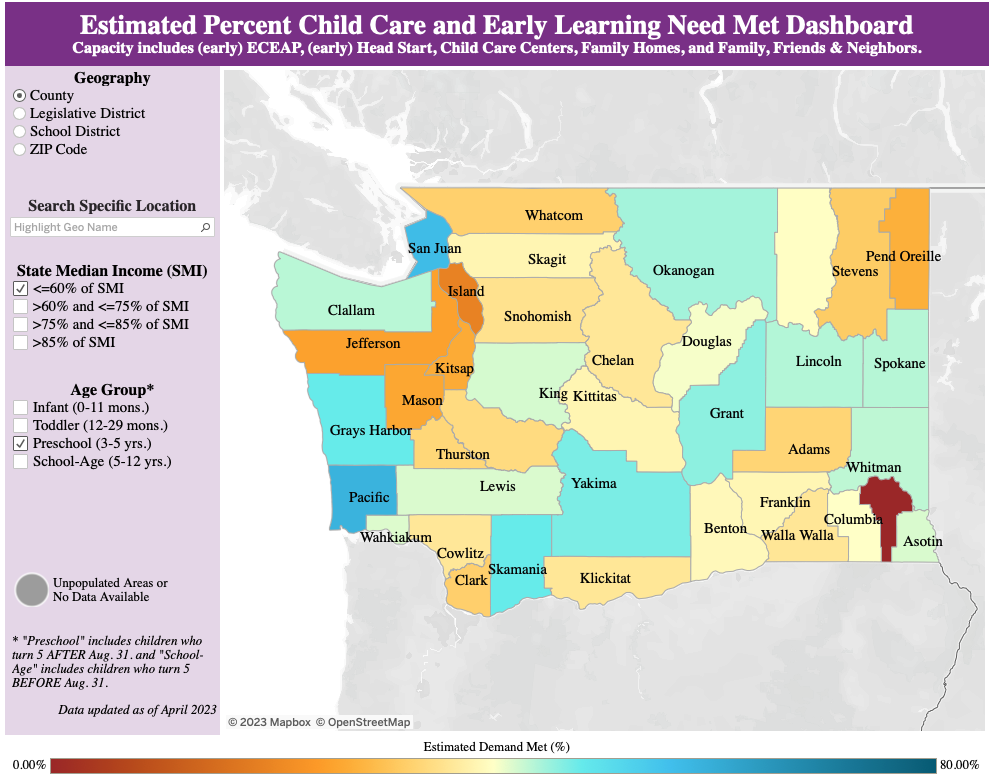Early Learning dashboards
Early Learning dashboards
OVERVIEW
Research has shown that access to early care and education has a major influence on a student’s future academic success. Until recently, data on the availability of child care in Washington state were not publicly available or were incomplete. The passage of the Fair Start for Kids Act in 2021 mandated more data transparency in this area, so Washington STEM partnered with the Department of Children, Youth, & Families (hereafter, DCYF) to develop Early Learning data dashboards. The first dashboard developed, Child Care and Early Learning Need and Supply identifies child care deserts and provides a baseline for measuring impact of the measures included in the Fair Start for Kids Act.
Washington STEM partnered with DCYF on four additional dashboards that measure how DCYF programs and grants affect equitable access to child care, including the allocation of federal grants, and the take-up of child care subsidies. Future dashboards are planned to measure access to the state’s Early Childhood Education Assistance Program (ECEAP) and Head Start, as well as early care and education workforce data.

Partnership
Washington STEM’s Early Learning initiative was launched in 2018 based on the knowledge that 90% of children’s brain development happens before age five. When we convened early learning advocates to identify systemic issues for improvement, they said the need for reliable, publicly-available data was top priority—not just for researchers and policy makers who use data forecasting to recommend policy supports, but for families and child care providers struggling to find and offer care.
The pandemic exacerbated these issues, and in 2021 as calls for a systemic response grew, Washington STEM reached out to DCYF’s Office of Innovation, Alignment, and Accountability to partner on the creation of the Child Care and Early Learning Supply and Need data dashboard and an interactive statewide map on their website. As a result of this partnership, Washington STEM produced four additional dashboards the following year, including those displaying geographic and demographic factors, uptake in child care subsidies, and the allocation of federal grants to stabilize child care businesses impacted by the pandemic. DCYF reported that this partnership with Washington STEM has helped build capacity in using data visualizations to communicate externally, and also as a forecasting tool to inform policy recommendations.
Direct Support
In 2021, after hearing from the early learning community that there was a need for greater data transparency in early care and education, Washington STEM offered direct technical support to DCYF to create data dashboards and embed them on their website. We started by pairing DCYF’s data on child care providers’ capacity with geographic data, such as zip codes, legislative and school districts, and fed it into data visualization software that power the dashboards. This collaboration has not only helped DCYF fulfill their legislative mandate to provide data on early learning and care to the public, but the technical support from Washington STEM also helped them build internal capacity to improve data visualization tools on their website.
After several rounds of data iteration between Washington STEM and DCYF staff, the dashboards were shared with community partners to gauge general accuracy and accessibility. The Early Learning Advisory Council, made up of parents, child care providers, health experts, legislators, representatives of Tribal Nations, independent schools, K-12 and higher education, and the Washington Communities for Children, a network of regional coalitions championing early learning, both provided feedback on the Early Learning dashboards before they were rolled out in 2022-2023.

Advocacy
The impetus for data dashboards grew out of the community-based conversations surrounding the State of the Children reports in 2019. Washington STEM heard from early learning advocates that a shift from prioritizing preschool to increasing access to child care would provide a more equitable foundation for children’s future academic success.
But when the pandemic forced thousands of child care providers to close, parents scrambled to find child care. This lack of child care resulted in increased absenteeism and parents leaving the workforce. In Olympia Washington STEM shared new data in the State of the Children reports that underscored the need to stabilize the child care industry. Soon after, the Fair Start for Kids Act (2021) was passed, a historic $1.2 billion investment in early learning and care, that expanded access to child care and called for increased data transparency. This led Washington STEM to partner with DCYF on the dashboards to display data visualizations related to their legislative mandates, such as tracking early learning need and supply and the uptake in child care subsidies across the state. Additional dashboards are planned for 2024.
Overall, the Early Learning data dashboards improve early learning data transparency for families and advocates, and help policy and lawmakers become aware of early learning trends to inform future legislative and policy recommendations.